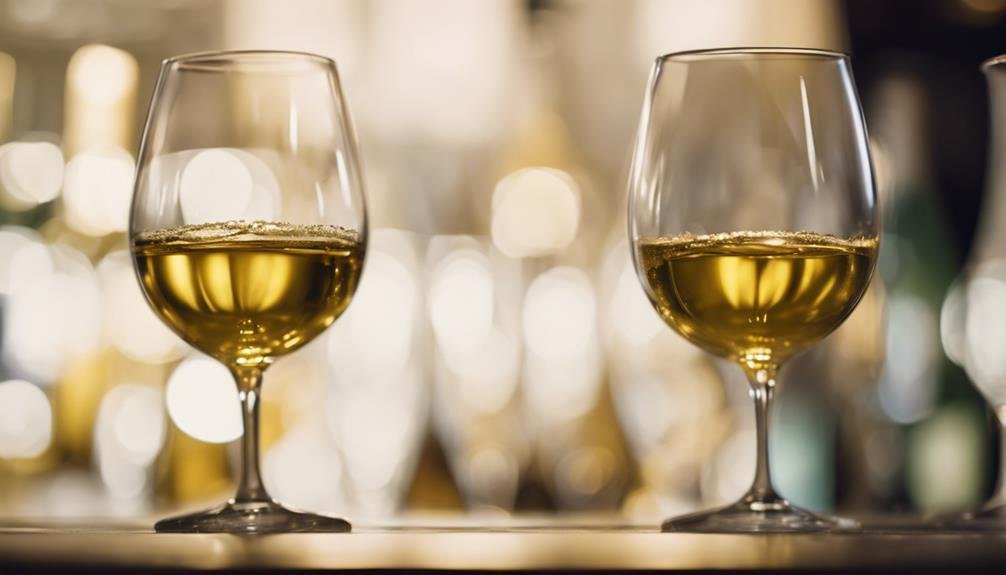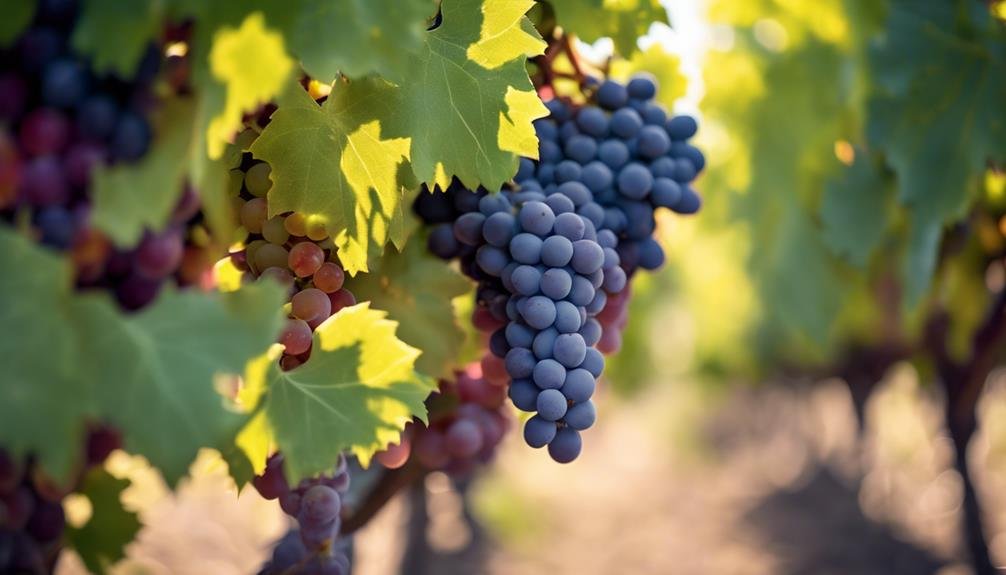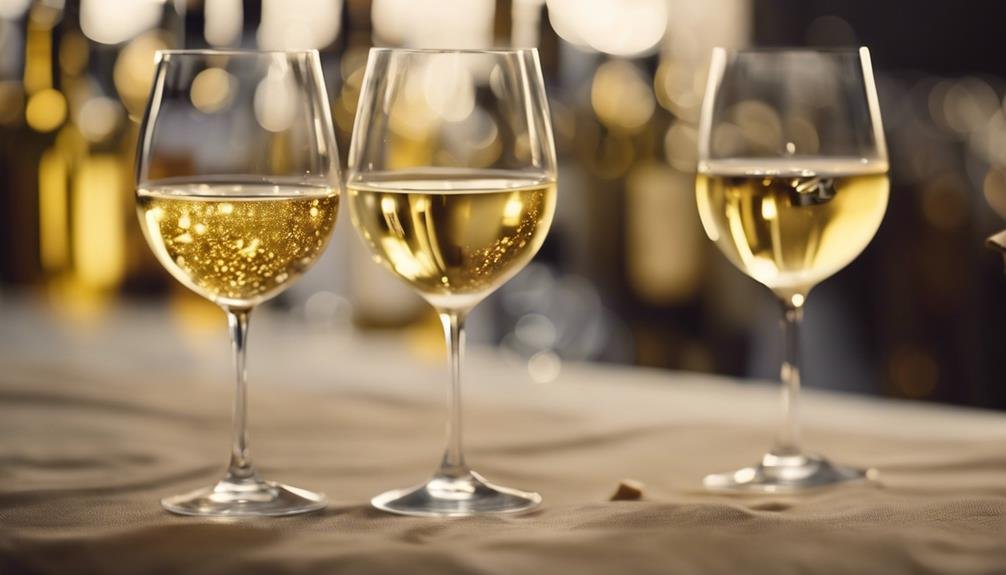Chardonnay and Viognier offer distinct aromatic experiences. Chardonnay boasts notes of yellow apple, lemon, and pear, producing a citrus-dominant, fruity complexity. In contrast, Viognier's floral intensity and citrus complexity, with tangerine, stone fruit, and exotic perfume aromas, create a unique profile. Taste-wise, Chardonnay explodes initially with a creamy finish, while Viognier has a softer start, an oily mid-palate, and invigorating lime-tangerine notes. Ideal pairings include Chardonnay with herbaceous chicken and Viognier with spicy seafood. Both grapes have interesting histories within winemaking. A deeper dive into these wines will reveal further intriguing details.
Aromatic Profiles of Chardonnay
The aromatic profile of Chardonnay is characterized by dominant notes of yellow apple and lemon, with nuances ranging from pineapple to lemon zest, particularly evident in cool-climate unoaked variations.
This citrus dominance creates a fruit complexity that distinguishes Chardonnay from other white wines. Cool climate differences play a significant role in enhancing these flavors, with pear highlights adding a layer of sophistication to the overall aroma.
The balance between the zesty citrus notes and the subtle sweetness of pear creates a harmonious bouquet that appeals to a wide range of wine enthusiasts.
Understanding these key elements of Chardonnay's aromatic profile can enrich the wine-tasting experience and deepen appreciation for this popular varietal.
Aromatic Profiles of Viognier
How does the aromatic profile of Viognier differ from that of Chardonnay?
Viognier is known for its distinct floral intensity and citrus complexity. The primary aromas of Viognier often include perfume and tangerine, along with flowery scents like rose petal. Sweet citrus notes, reminiscent of tangerine creamsicle, add a unique touch. Additionally, fleshy stone fruit aromas and exotic perfume, as well as tropical fruit notes, contribute to the aromatic complexity of Viognier.
These characteristics set Viognier apart from Chardonnay, showcasing a more floral and citrus-driven aromatic profile that appeals to those seeking a vibrant and aromatic white wine experience.
Contrasting Taste Profiles

In comparing the taste profiles of Chardonnay and Viognier, discernible differences emerge in their sensory compositions. Chardonnay presents an explosive initial taste that culminates in a creamy finish, offering a rich and velvety sensation on the palate.
On the other hand, Viognier starts with a softer introduction and features an oily mid-palate, giving it a unique textural quality. The finish of Viognier is marked by invigorating limey-tangerine notes, adding a zesty twist to its overall taste profile. Despite their weight similarities, Viognier may exhibit bitter almond-husk aromas towards the end.
These contrasting elements contribute to the distinct character and appeal of Chardonnay and Viognier wines.
Ideal Food Pairings
Discovering ideal culinary companions for Chardonnay and Viognier reveals a world of harmonious flavor pairings. Chardonnay's crisp acidity and citrus notes make it a perfect match for herbaceous chicken dishes, enhancing the flavors of green herbs and cream-based sauces. Additionally, Chardonnay's lemon and yellow apple aromas beautifully complement lean white proteins like chicken and scallops.
On the other hand, Viognier's exotic perfume and fruity aromas pair wonderfully with spicy seafood dishes, especially those seasoned with Moroccan or Tunisian spices. The Viognier's oily texture also complements butter-poached shrimp, while its aromatic qualities enhance dishes featuring ginger or paprika. These ideal food pairings showcase the versatility of Chardonnay and Viognier in enhancing a wide range of culinary experiences.
Grape Origins and Relationships

The origins and relationships of Chardonnay and Viognier grape varieties are intricately linked to their respective pedigrees within the world of wine. Chardonnay finds its place within the esteemed Pinot pedigree, showcasing a connection to the renowned Pinot Noir grape.
On the other hand, Viognier emerges from the Syrah pedigree, indicating a close relationship to the bold and flavorful Syrah grape. It is interesting to note that regions known for producing exceptional Syrah wines also tend to excel in cultivating Viognier grapes.
This parallel mirrors the dynamic between Pinot Noir and Chardonnay, highlighting how Viognier and Syrah can harmonize with more robust flavors in dishes compared to the delicate nature of Chardonnay and Pinot Noir.
Frequently Asked Questions
Can Chardonnay Be Aged Like Viognier?
Both Chardonnay and Viognier have aging potential, yet Chardonnay tends to age longer due to its higher acidity and structure. While Viognier shines with its floral and fruity aromas, Chardonnay develops a more complex flavor profile over time.
Are There Any Dessert Pairings for Chardonnay?
For dessert pairings with Chardonnay, consider delicate green herb-infused sorbets or lemon-themed desserts. Chardonnay cocktails with citrus or apple notes can complement light, fruity desserts. Viognier sorbet provides a invigorating, aromatic contrast.
Can Viognier Be Used in Cooking?
Viognier, known for its floral and fruity aromas, can enhance various dishes through its unique characteristics. When incorporated into Viognier recipes, its aromatic profile and subtle acidity make it a versatile choice for culinary uses.
Do Chardonnay and Viognier Have Different Acidity Levels?
Chardonnay generally exhibits higher acidity levels compared to Viognier. The crisp acidity in Chardonnay complements its citrus and apple notes, making it versatile for pairing with various foods. Viognier, with a softer acidity, enhances its floral and tropical fruit flavors.
Can Viognier Be Blended With Other Grape Varieties?
Yes, Viognier can be blended with other grape varieties to enhance complexity and flavor profiles. Viognier blends offer a unique aromatic and textural experience, suitable for crafting exquisite wines and innovative Viognier cocktails that showcase its versatile nature.
Conclusion
To sum up, the contrast between Chardonnay and Viognier is a fascinating exploration of aromatic diversity in the world of white wines.
While Chardonnay boasts crisp yellow apple and lemon notes, Viognier delights with its perfume and tangerine aromas.
Understanding these nuanced differences can enhance one's appreciation for the unique characteristics of each varietal, making the choice between Chardonnay and Viognier a delightful journey of sensory discovery.
